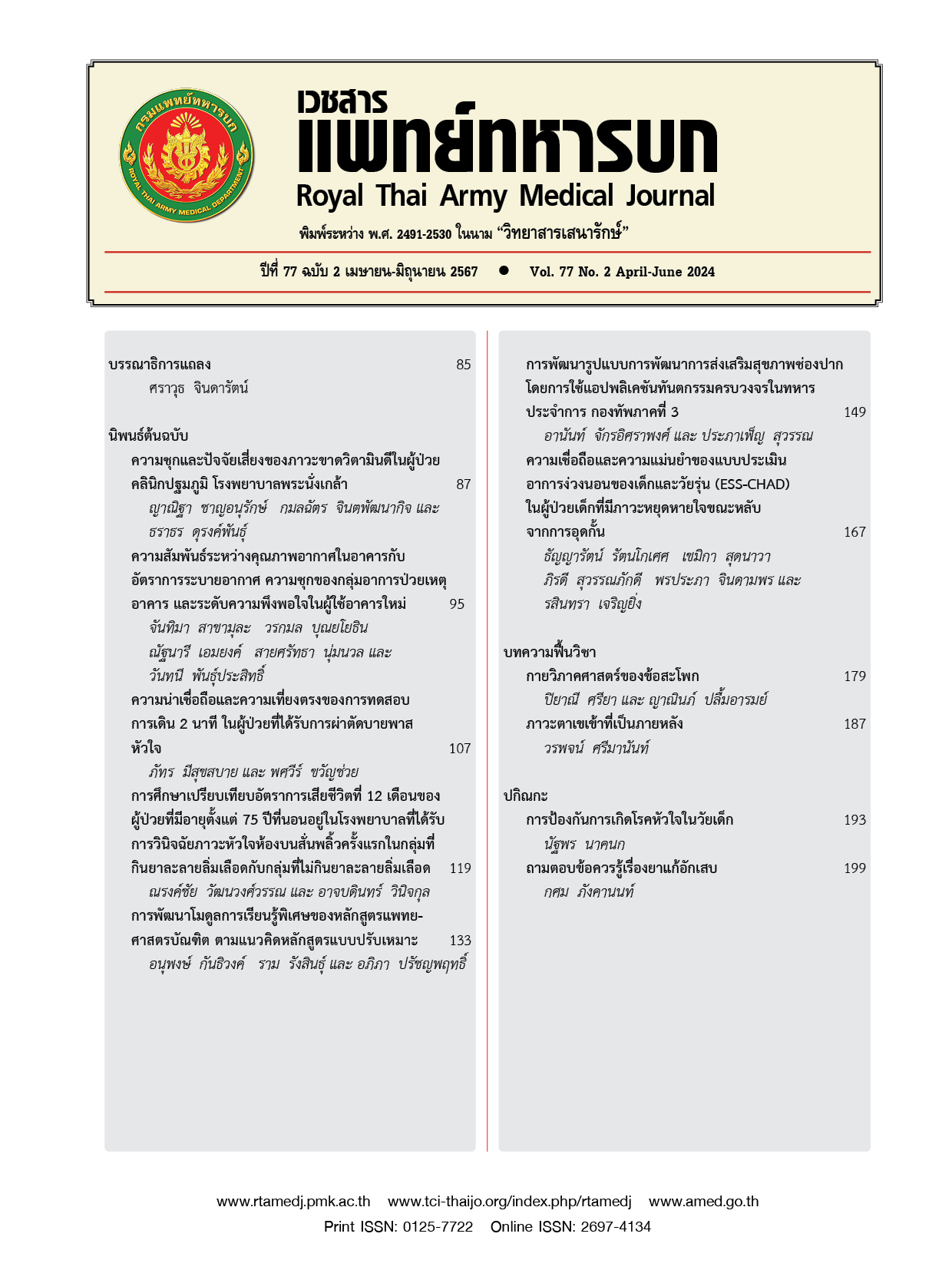ภาวะตาเขเข้าที่เป็นภายหลัง
Main Article Content
Downloads
Article Details

This work is licensed under a Creative Commons Attribution-NonCommercial-NoDerivatives 4.0 International License.
Articles in this journal are copyrighted by the Royal Thai Army Medical Department and published under the Creative Commons Attribution-NonCommercial-NoDerivatives 4.0 International (CC BY-NC-ND 4.0) license.
may be read and used for academic purposes, such as teaching, research, or citation, with proper credit given to the author and the journal.
Use or modification of the articles is prohibited without permission.
Statements expressed in the articles are solely the opinions of the authors.
Authors are fully responsible for the content and accuracy of their articles.
Any other republication of the articles requires permission from the journal.
References
Khan AO, Chang TCP, El-Dairi M, Lee KA, Utz VM, Mireskandari K, et al., editors. Pediatric ophthalmology and strabismus. 2023rd-2024th, last major revision 2022-2023 ed. San Francisco, Calif: American Academy of Ophthalmology; 2023. 499 p. (Basic and clinical science course/American Academy of Ophthalmology).
Burian HM, Miller JE. Comitant convergent strabismus with acute onset. Am J Ophthalmol. 1958;45(4 Pt 2):55-64.
Clark AC, Nelson LB, Simon JW, Wagner R, Rubin SE. Acute acquired comitant esotropia. Br J Ophthalmol. 1989;73(8):636-8.
Buch H, Vinding T. Acute acquired comitant esotropia of childhood: a classification based on 48 children. Acta Ophthalmol (Copenh). 2015;93(6):568-74.
Neena R, Giridhar A. Acute acquired comitant esotropia in children: A benign entity or an ominous sign? Kerala J Ophthalmol. 2019;31(1):33.
Topcu Yilmaz P, Ural Fatihoglu Ö, Sener EC. Acquired Comitant Esotropia in Children and Young Adults: Clinical Characteristics, Surgical Outcomes, and Association With Presumed Intensive Near Work With Digital Displays. J Pediatr Ophthalmol Strabismus. 2020;57(4):251-6.
Roda M, Pellegrini M, Rosti A, Fresina M, Schiavi C. Augmented bimedial rectus muscles recession in acute acquired concomitant esotropia associated with myopia. Can J Ophthalmol J Can Ophtalmol. 2021;56(3):166-70.
Zhu M, Tang Y, Wang Z, Shen T, Qiu X, Yan J, et al. Clinical characteristics and risk factors of acute acquired concomitant esotropia in last 5 years: a retrospective case-control study. Eye Lond Engl. 2023;37(2):320-4.
Neena R, Remya S, Anantharaman G. Acute acquired comitant esotropia precipitated by excessive near work during the COVID-19-induced home confinement. Indian J Ophthalmol. 2022;70(4):1359.
Vagge A, Giannaccare G, Scarinci F, Cacciamani A, Pellegrini M, Bernabei F, et al. Acute Acquired Concomitant Esotropia From Excessive Application of Near Vision During the COVID-19 Lockdown. J Pediatr Ophthalmol Strabismus. 2020;57:e88-e91. Erratum in: J Pediatr Ophthalmol Strabismus. 2020;57(6):408.
Lee HS, Park SW, Heo H. Acute acquired comitant esotropia related to excessive Smartphone use. BMC Ophthalmol. 2016;16(1):37.
Hoyt CS, Good WV. Acute onset concomitant esotropia: when is it a sign of serious neurological disease? Br J Ophthalmol. 1995;79(5):498-501.
Akman A, Dayanir V, Sanaç AS, Kansu T. Acquired esotropia as presenting sign of cranio-cervical junction anomalies. NeuroOphthalmol. 1995;15(6):311-4.
Lyons CJ, Tiffin PA, Oystreck D. Acute acquired comitant esotropia: a prospective study. Eye Lond Engl. 1999;13(Pt 5):617-20.
Spierer A. Acute concomitant esotropia of adulthood. Ophthalmology. 2003;110(5):1053-6.
Kassem RR, Elhilali HM. Factors affecting sensory functions after successful postoperative ocular alignment of acquired esotropia. J AAPOS Off Publ Am Assoc Pediatr Ophthalmol Strabismus. 2006;10(2):112-6.
Chen J, Deng D, Sun Y, Shen T, Cao G, Yan J, et al. Acute Acquired Concomitant Esotropia: Clinical features, Classification, and Etiology. Medicine (Baltimore). 2015;94(51):e2273.
Von Noorden GK, Campos EC. Binocular vision and ocular motility: theory and management of strabismus. 6th ed. St. Louis, Mo: Mosby; 2002. 653 p.
Anderson WD, Lubow M. Astrocytoma of the Corpus Callosum Presenting with Acute Comitant Esotropia. Am J Ophthalmol. 1970;69(4):594-8.
Lewis AR, Kline LB, Sharpe JA. Acquired esotropia due to Arnold-Chiari I malformation. J Neuro-Ophthalmol Off J North Am Neuro-Ophthalmol Soc. 1996;16(1):49-54.
Biousse V, Newman NJ, Petermann SH, Lambert SR. Isolated comitant esotropia and Chiari I malformation. Am J Ophthalmol. 2000;130(2):216-20.
Scheiman M, Gallaway M, Ciner E. Divergence insufficiency: characteristics, diagnosis, and treatment. Am J Optom Physiol Opt. 1986;63(6):425-31.
Wiggins RE, Baumgartner S. Diagnosis and management of divergence weakness in adults. Ophthalmology. 1999;106(7):1353-6.
Oatts JT, Salchow DJ. Age-related distance esotropia - fusional amplitudes and clinical course. Strabismus. 2014;22(2):52-7.
Nardi M, Dal Pozzo G, Romani A, Barca L. Divergence pseudoparalysis: A case report. Graefes Arch Clin Exp Ophthalmol. 1986;224(4):371-3.
Lim L, Rosenbaum AL, Demer JL. Saccadic Velocity Analysis in Patients With Divergence Paralysis. J Pediatr Ophthalmol Strabismus. 1995;32(2):76-81.
Schanzer B, Bordaberry M. The Child With Divergence Paresis. Surv Ophthalmol. 1998 ;42(6):571-6.
Dawson ELM, Marshman WE, Adams GGW. The role of botulinum toxin a in acute-onset esotropia 11The authors have no financial interest in the material presented in this article. Ophthalmology. 1999;106(9):1727-30.
Shi M, Zhou Y, Qin A, Cheng J, Ren H. Treatment of acute acquired concomitant esotropia. BMC Ophthalmol. 2021;21(1):9.
Repka MX, Connett JE, Scott WE. The One-year Surgical Outcome after Prism Adaptation for the Management of Acquired Esotropia. Ophthalmology. 1996;103(6):922-8.
Savino G, Colucci D, Rebecchi MT, Dickmann A. Acute Onset Concomitant Esotropia: Sensorial Evaluation, Prism Adaptation Test, and Surgery Planning. J Pediatr Ophthalmol Strabismus. 2005;42(6):342-8.
Lang L juan, Zhu Y, Li Z gang, Zheng G ying, Peng H ying, Rong J bo, et al. Comparison of botulinum toxin with surgery for the treatment of acute acquired comitant esotropia and its clinical characteristics. Sci Rep. 2019;9(1):13869.
Lee HJ, Kim SJ. Clinical characteristics and surgical outcomes of adults with acute acquired comitant esotropia. Jpn J Ophthalmol. 2019;63(6):483-9.
Ohtsuki H, Hasebe S, Kobashi R, Okano M, Furuse T. Critical Period for Restoration of Normal Stereoacuity in Acute-onset Comitant Esotropia. Am J Ophthalmol. 1994;118(4):502-8.
Schöffler C, Sturm V. Repeated Surgery for Acute Acquired Esotropia: Is It Worth the Effort? Eur J Ophthalmol. 2010;20(3):493-7.


